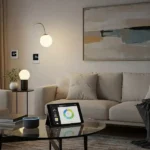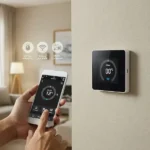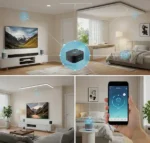Tune In, Take Control: Mastering Your Media Smart Home
Smart devices have revolutionized how we interact with technology, especially our entertainment. From TVs that stream on command to speakers that play your favorite playlists with a voice prompt, media-related smart devices offer convenience and a personalized experience. But how do you manage this interconnected ecosystem? This guide will walk you through monitoring and controlling your media smart home, highlighting the benefits, drawbacks, and different network options available.
What are Media-Related Smart Devices?
These are internet-connected devices designed for entertainment and information consumption. Common examples include:
- Smart TVs: Offer streaming apps, voice control, and integration with other smart devices.
- Smart Speakers: Play music, podcasts, and audiobooks, often with built-in virtual assistants.
- Smart Soundbars & Stereo Systems: Enhance audio quality and integrate into a smart home ecosystem.
- Streaming Devices (e.g., Chromecast, Roku, Apple TV): Turn regular TVs into smart TVs and offer access to various streaming services.
- Smart Projectors: Provide a large-screen viewing experience with smart features.
- Smart Digital Photo Frames: Display photos and often integrate with cloud storage and smart assistants.
The Power of a Smart Network for Media
A smart network connects these individual devices, allowing them to communicate and work together seamlessly. Imagine:
- Voice Control: Telling your smart speaker to play a movie on your smart TV and dim the smart lights simultaneously.
- Multi-Room Audio: Streaming the same music throughout your home or different playlists in each room.
- Centralized Control: Managing all your media devices through a single app on your smartphone or tablet.
- Automation: Setting up routines like automatically turning on the TV and soundbar when your streaming device starts playing.
- Personalized Experiences: Some systems learn your preferences and suggest content you might enjoy across different devices.
Pros and Cons of Using a Smart Network
Pros:
- Convenience: Control all your media from one place or with voice commands.
- Enhanced Entertainment: Create immersive experiences with synchronized lighting and audio.
- Automation: Automate routine tasks for a more streamlined experience.
- Interoperability: Devices from different manufacturers can often work together.
- Personalization: Tailor your entertainment experience to your preferences.
Cons:
- Complexity: Setting up and managing a smart network can be challenging initially.
- Cost: Smart devices often come with a higher price tag than their traditional counterparts.
- Internet Dependency: A stable internet connection is crucial for functionality.
- Security Risks: Connected devices can be potential targets for cyberattacks if not properly secured.
- Privacy Concerns: Data collected by smart devices raises privacy questions.
- Compatibility Issues: Not all devices work seamlessly together, requiring research before purchasing.
Types of Smart Networks for Your Home
Several technologies can form the backbone of your media smart home:
- Wi-Fi: The most common wireless networking standard, connecting devices to your router.
- Bluetooth: A short-range wireless technology ideal for direct connections between devices (e.g., phone to speaker).
- Zigbee: A low-power wireless protocol designed for smart home devices, often requiring a hub.
- Z-Wave: Another low-power wireless protocol competing with Zigbee, also typically needing a hub.
- Ethernet: Wired connections offering the most stable and fastest speeds, suitable for bandwidth-intensive devices like smart TVs and gaming consoles.
Comparing Smart Network Features
| Feature | Wi-Fi | Bluetooth | Zigbee | Z-Wave | Ethernet |
|---|---|---|---|---|---|
| Range | Medium to Long | Short | Short to Medium (with mesh) | Short to Medium (with mesh) | Limited by cable length |
| Speed/Bandwidth | High | Low to Medium | Low | Low | Very High |
| Power Consumption | Moderate to High | Low | Very Low | Very Low | N/A (Wired) |
| Topology | Star (Router-centric), Mesh (some) | Point-to-Point, Broadcast | Mesh | Mesh | Star (Switch/Router-centric) |
| Complexity | Relatively Simple | Very Simple | More Complex (requires hub) | More Complex (requires hub) | Simple (physical connection) |
| Best For Media | Streaming, general internet access | Direct audio connections (headphones) | Control of low-bandwidth devices | Control of low-bandwidth devices | High-bandwidth streaming, gaming |
| Hub Required? | Usually not (connects to Wi-Fi router) | No | Yes (typically) | Yes (typically) | No (connects to router/switch) |
Choosing the right smart network technologies depends on your specific needs, the types of devices you have, and your technical comfort level. Often, a combination of these technologies (e.g., Wi-Fi for streaming, Zigbee for smart lighting) provides the best overall experience.
Media Smart Home – Take Control of Your Media Universe
Monitoring and controlling your media smart home doesn’t have to be daunting. By understanding the different types of smart devices, the benefits of a smart network, and the available connection technologies, you can create a seamless and enjoyable entertainment experience tailored to your lifestyle. Remember to prioritize security and research device compatibility to build a smart home that truly works for you.
Frequently Asked Questions (FAQs) About Your Media Smart Home
Q1: What’s the main benefit of connecting my media devices to a smart network? A1: The primary benefit is enhanced convenience and control. A smart network allows you to manage all your media devices (TVs, speakers, soundbars) from a single app or with voice commands, enabling features like multi-room audio, personalized entertainment, and automation of entertainment routines.
Q2: Do I need a special hub for all my smart media devices? A2: It depends on the devices and the network technology they use. While many Wi-Fi devices connect directly to your existing Wi-Fi router, protocols like Zigbee and Z-Wave typically require a dedicated hub or bridge to facilitate communication with other smart devices and your main network.
Q3: Can I mix and match smart media devices from different brands? A3: Yes, often you can, but compatibility is key. Many smart devices support open standards or integrate with popular smart home platforms (like Google Home, Amazon Alexa, Apple HomeKit). However, some features might be limited, or you might need multiple apps to control everything. Always check device specifications for compatibility before purchasing.
Q4: Is it complicated to set up a smart network for my media devices? A4: Initial setup can require some time and effort, especially if you’re integrating many different devices or technologies. However, most modern smart devices come with user-friendly apps and instructions to guide you through the process. Starting with a few devices and gradually expanding your setup can make it less daunting.
Q5: How do I typically control my smart media devices once they’re networked? A5: Common control methods include: * Smartphone/Tablet Apps: Dedicated apps from manufacturers or centralized smart home platforms. * Voice Assistants: Smart speakers or displays with built-in virtual assistants (e.g., Alexa, Google Assistant, Siri). * Smart Remotes: Universal remotes designed to control multiple smart devices. * Physical Buttons: Some devices have physical controls for basic functions.
Q6: What are the security and privacy risks associated with smart media devices? A6: Like any internet-connected device, smart media devices can be vulnerable to cyber threats if not properly secured. Risks include unauthorized access to your network, data breaches, and privacy concerns related to collected usage data. It’s crucial to use strong, unique passwords, enable two-factor authentication, keep device firmware updated, and be aware of a device’s privacy policy.
Q7: Will a smart network affect my internet speed or Wi-Fi performance? A7: A large number of smart devices all competing for Wi-Fi bandwidth can potentially impact your network’s performance, especially if you have a slow internet connection or an older router. Devices using low-bandwidth protocols like Zigbee or Z-Wave have minimal impact. For high-bandwidth activities like 4K streaming, consider wired Ethernet connections where possible.
Q8: Can I still use my smart media devices if my internet goes down? A8: Basic functions might still work via direct connections (e.g., Bluetooth for speakers) or local network control if your router is still operating. However, most smart features, cloud-based commands, streaming services, and remote control capabilities will be unavailable without an active internet connection.
Additional helpful information
Here is some helpful information about setting up a smart home – How to Set Up a Smart Home?
More details about useful smart home gadgets – Most Useful Smart Home Gadgets




